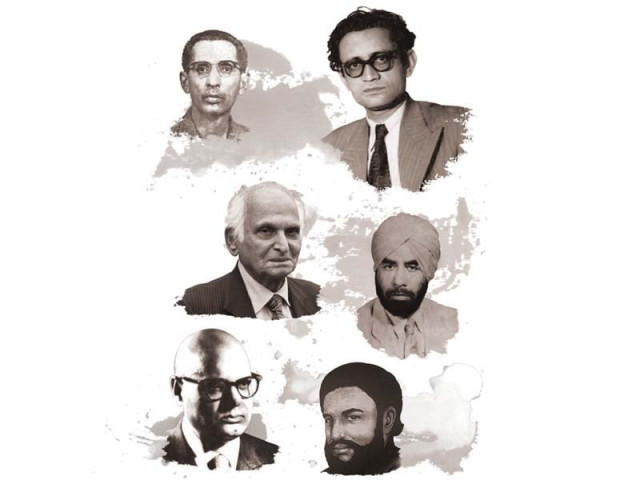
However, his quote, when taken as a guiding principle, may lead us to conclude that Muzafar Ali Syed’s posthumously published collection of critical essays (he has used the word ‘theses’ for them) belongs to the third category – the ‘few’ books to be thoroughly chewed and digested.
In fact, Syed’s Sukhan aur Ahl-e-Sukhan is one of those conscientious works in which it will be difficult to pinpoint any redundancy, contradictions and vague or careless use of word and ideas. It is a work of admirable intellectual integrity and a subtlety which demands an attentive reader and sometimes multiple – but rewarding – readings.
As Asif Farrukhi points out in his review of the book in question, Syed’s essays demonstrate his breath of interests – his keen knowledge and understanding of both Eastern and Western literary and critical traditions, his deep critical appreciation of both fiction and poetry and his awe-inspiring understanding of linguistic nuances and precision.
A mere review of the book’s table of contents reveals Syed’s diversity of interest, which in terms of topics can be broadly put into four general categories.
These include essays on general literary topics like dynamics of translation, relationship between sounds and words, crisis of Urdu literature and importance of historical consciousness; essays on fiction writers like Ghulam Abbas, Manto, Rajinder Singh Bedi and Intizar Hussain; essays on poets like Mir Taqi Mir, Noon Meem Rashid, Mirajee and Majeed Amjad and essays on critics like Saleem Ahmed and Niaz Fatehpuri.
But what Syed has done with these topics is of real interest.
In his essay on Hussain, the critic has said that he evaluates even the writings of his friends with an ‘antagonistic’ spirit. This apparently is an exaggeration that strongly communicates his very objective view of things and extremely balanced analyses.

Syed has described criticism at one place as a ‘logical discourse’ on literature and at another place as an activity in which the critic takes on the role of a judge. And the critic has remained true to his ideal throughout the essays.
You can disagree with Syed’s critical judgments and conclusions but you cannot question his clarity of mind, his erudition, his precise use of language and his comprehensiveness.
Particularly, his essays on Abbas’s post-Anandi stories, the influence of Iran’s World War II situation and contemporary poetry on Rashid, the cogent defence of the generally underrated Amjad and Mir’s little discussed Persian poetry are definitive works, which have a semblance of being a final word on the topics.
Syed generally has a smooth, highly intellectual but conversational style that reminds one of Muhammad Hasan Askari, a man who is repeatedly referred to in the essays in different contexts.
However, unlike Askari whose writings show a gradual evolution in thought and ideals, Syed’s essays – included in the collection – represent a rather permanent outlook on literature.
Farrukhi suggests that Syed is not remarkable as an innovator of critical method. However, in spite of this, his works reflect an unusual intelligence.
Syed generally approaches a subject by presenting what the writer or his critics have said about the work in question and then gradually analyses these judgments, sometimes in the light of the work itself. However, as he proceeds logically and chronologically, he creates a convincing picture that sheds a new light on his subject.
And during this analysis, he often reaches the heart of the matter. This is the point where his style becomes increasingly supple as he draws to his conclusions with a creative insight.
However, one does not find him forming an elaborate literary theory like Askari’s traditional criticism or Ahmed’s theory of ‘decimal and whole man’. And resultantly his writings do not provide as great a perspective as the writings of his two other contemporaries.
A recurrent theme in his writings is the idea of conflict. Syed seeks to know how conflicting forces are at work in art and life and what pattern is formed by their interaction. Jadalyaat is the word that can be spotted in many of his essays but it is never used in the Marxist context of dialectic materialism.
Apparently, Syed believes that the absence of a conflict means the absence of a story and, by extension, absence of literature. Now it is the job of our new critics to find out what were the conflicting forces that gave this remarkable poise and balance to his writings, which seem to claim a permanent place in Urdu’s critical tradition.
The writer is a staffer at The Express Tribune
Published in The Express Tribune, September 18th, 2016.
Like Life & Style on Facebook, follow @ETLifeandStyle on Twitter for the latest in fashion, gossip and entertainment.

















COMMENTS
Comments are moderated and generally will be posted if they are on-topic and not abusive.
For more information, please see our Comments FAQ